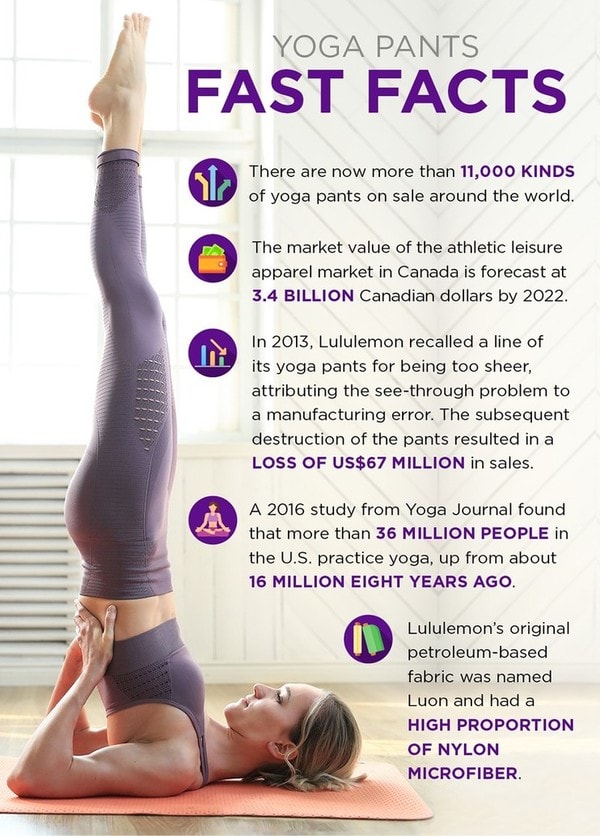
Yoga apparel and athletic wear in general rely on fabrics that are lightweight, breathable, stretchable and sweat-wicking: a combination made possible by synthetic fibres made from oil and gas.
What do you think about when you’re downward dogging? Or when you’re moving through cat cow pose? Hopefully, the answer is “nothing”, and you’re merely enjoying a moment of peace as you stretch and tone your body at the local yoga studio or in front of your favourite Apple Fitness or Peloton workout. And while many thoughts may float in and out, you’re likely not considering the composition of your yoga pants.
But did you know that these comfortable, breathable and light weight clothes that allow you to bend and stretch every which way, are made from petroleum? Yoga pants, and in general, much of the active wear we use when running, training or frankly, just hanging out (because they are so comfortable!) are made of a unique combination of spandex (aka lycra) and nylon, which are both derivatives of petrochemicals.
First invented by Vancouver-based Lululemon in 1998, the first yoga pants were made of synthetic elastic fibers that provided both the stretch and softness needed for a lengthy session on the mat. They were presented as an alternative to cotton leggings and no one could have predicted how these simple pants would lead to a yoga revolution that would not only take place in the studio, but in our closets.
Today, just over twenty years later, more yoga pants are being sold across North America than jeans. Companies are also betting big on the men’s “athleisure” market—athletic clothes that perform double duty and can be worn for comfort or for sport, both inside and outside of the gym—with the segment steadily on the rise. Lululemon sees its male athletic wear growing to $1 billion.The Evolution of Petroleum-based Textiles
The marriage of petroleum and textiles started over 85 years ago. Today, about half of all fibres used by the textile business come from oil and natural gas, amounting to approximately 38 million tons of synthetic fibre annually. In addition to nylon and spandex, polyester, acrylic and acetate are all made using fossil fuels.
In fact, most common manufactured fibers are petroleum-based. Each manufactured fiber has its own petrochemical base and method of production; in particular, how the filaments (i.e., threads) are processed affect the finished fabric. For instance, acrylic is lightweight, soft and has a wool-like feel; polyester is strong and resistant to wrinkles and shrinking; nylon has good elasticity and resilience with a nice “draping” quality; and spandex has excellent stretch and durability without pilling or building up static. Each has a distinct look, feel and properties. In many cases, synthetic fibres are blended with each other and/or cotton in different proportions to achieve a desired amount of warmth, stretchiness and breathability.

In addition to the common petroleum-based fibers, savvy yoga pants manufacturers are working to develop new synthetic fabrics to stay ahead of the many competitors in the active wear field. Today’s yoga pants often come with hefty price tags, and in return, consumers are expecting quality garments in exchange for their dollars. Garments that not only stand up to frequent washing, and wear and tear, but that have extra features like climate control or sweat wicking. Others are looking for recycled materials in their active gear. In response, some manufacturers are now recycling post-consumer polyethylene terephthalate (PET) soda bottles into polyester fibers.
In short, what was once just a legging has become a marvel of chemistry and engineering. Yoga pants, and active wear, in general, is a growing market that is capitalizing on the consumer’s desires to be comfortable while getting fit—more than a trend, yoga (and all that it stands for) is now entrenched as a movement that encompassed not only fitness, but lifestyle and fashion.
Timeline of Petroleum-Based Fabrics: AKA the inventions that led up to yoga pants
- 1935: Wallace Hume Carothers invents nylon – it is the first fibre produced from a petrochemical (benzene).
- 1941: Building on Carothers’ work, John Whinfield and James Dickson invent polyester, using the petrochemical ethylene.
- 1959: Lycra (spandex) is created by Joseph Shivers came from the petrochemical propylene.
- 1998: Lululemon puts together nylon and spandex to create their iconic yoga pants.
Share This:
You can read more of the news on source



